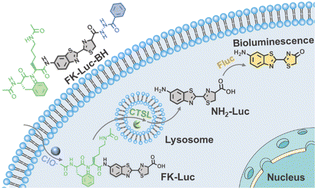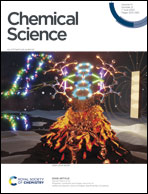An AND-gate bioluminescent probe for precise tumor imaging†
Abstract
Sensitivity and specificity are two indispensable requirements to ensure diagnostic accuracy. Dual-locked probes with “AND-gate” logic theory have emerged as a powerful tool to enhance imaging specificity, avoid “false positive” results, and realize correlation analysis. In addition, bioluminescence imaging (BLI) is an excitation-free optical modality with high sensitivity and low background and can thus be combined with a dual-locked strategy for precise disease imaging. Here, we developed a novel AND-gate bioluminescent probe, FK-Luc-BH, which is capable of responding to two different tumor biomarkers (cathepsin L and ClO−). The good specificity of FK-Luc-BH was proven, as an obvious BL signal could only be observed in the solution containing both cathepsin L (CTSL) and ClO−. 4T1-fLuc cells and tumors treated with FK-Luc-BH exhibited significantly higher BL signals than those treated with unresponsive control compound Ac-Luc-EA or cotreated with FK-Luc-BH and a ClO− scavenger/cathepsin inhibitor, demonstrating the ability of FK-Luc-BH to precisely recognize tumors in which CTSL and ClO− coexist.



 Please wait while we load your content...
Please wait while we load your content...